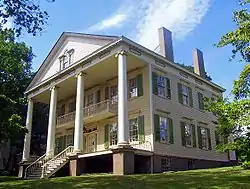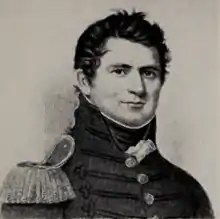David Crawford House
The David Crawford House is a historic house located at 189 Montgomery Street in Newburgh, Orange County, New York. It currently serves as a museum, archive and headquarters for the Historical Society of Newburgh Bay and The Highlands.[2]
David Crawford House | |
 The house in 2007 | |
  | |
| Location | 189 Montgomery St., Newburgh, NY |
|---|---|
| Coordinates | 41°30′32″N 74°00′29″W |
| Built | 1834 |
| Architectural style | Neoclassical |
| Part of | Montgomery-Grand-Liberty Streets Historic District (ID73001246) |
| NRHP reference No. | 72000899 |
| Significant dates | |
| Added to NRHP | September 27, 1972[1] |
| Designated CP | July 16, 1973 |
Description and history

The mansion could be described as a conjunction of the Neoclassical, Greek Revival and late Federal-styles.[3] It was built by David Crawford, who had made his fortune in Hudson River shipping in during the 1830s.[4] Crawford was leased the land on March 8th, 1830, by the Trustees of the Glebe, for a period of 900 years.[5] His family originated from Ulster, and immigrated to America in 1731, settling Little Britain alongside the Clinton family. The Crawfords moved to Newburgh in 1806 as David's father, Francis, saw a burgeoning market for agricultural products.[6] With Eunice Watkins of Campbell Hall, he had four sons: David, Thomas, Samuel and James.[5] The brothers and their mother succumbed to tuberculosis, and David ameliorated his health by accepting a job as a deputy sheriff in 1810.[6] Frequent horseback-riding built up his immunity.
As the War of 1812 broke out, Crawford enlisted in the army and formed a volunteer company which relocated to New York Harbor.[5] He became attached to an artillery regiment and eventually promoted to captain. After spending time in the harbor, he gained an understanding of shipping and maritime trade, becoming interested in their economic benefits.[6]
In May 1822, David Crawford married Fanny C. Belknap, daughter of General Isaac Belknap.[5] They had two daughters, Mary Elizabeth, called "Lib", and Anna. In 1825, he became involved in the building of a steamboat to freight goods from Newburgh to New York City. The steamer Baltimore, purchased during the winter of 1829—1830, began shipping from D. Crawford & Co.'s wharf that spring.[7]
Architecture

The architect of the house remains unknown, but speculation hints that the Crawford House was not their only work in the area. William Roe, a retired grocer, had a mansion of very similar architecture[8] completed in 1826.[9] Benjamin Carpenter, a merchant and factory owner,[10] had a mansion on High Street. Even earlier,[11] in 1800, a house with a similar floor plan was occupied by Samuel Williams and later Francis Gouldie.[12] The house, later known as Clisophic Hall, was built for the Rev. Jonathan Freeman,[13] who led the United Church. It became the Newburgh Home for the Friendless in 1861.[14] All four structures featured a large central hall that spanned the first floor, with double parlors on either side. A large doorway divided the hall, but only the Crawford House features a transom and sidelights.[12] Only the Roe Mansion and Crawford House remain standing.
Architrave trim of an elaborate design gives a flaunting impression, and carved laurel details in rectangles above the doors are seen consistently. The free-standing stairs have mahogany balustrades and elegant brackets. A most curious detail of the staircase is the iconic newel post, a carved dolphin head. It is thought to be the work of a Massachusetts ship figurehead carver.[5] On the west end of the first floor, an alcove addition is now staged as a small library.[3]
The house's kitchen was in the basement, and now used by the Historical Society as a museum.[3] Above the house's river-facing east entrance, a former sewing room also holds artifacts. The doors of the upstairs floor, and most on the main floor, are pine, painted with faux bois.[3]
Perhaps the house's most imposing element is its large pediment, centered with a Palladian window, supported by four 40'[5] ionic columns.
Historical Society's Acquisition
On October 3rd, 1953, the house was scheduled for a public auction. Many feared the nearby funeral home would purchase and demolish it to make room for a parking lot. On September 28th, the Historical Society of Newburgh Bay & The Highlands decided to purchase the house.[5] The Ossoli Club, Trustees of Washington's Headquarters and the Daughters of the American Revolution also contributed to the purchase as well as subsequent fundraising.
Period furniture was donated for the interior, including a Duncan Phyfe sofa.[3] Senator Thomas C. Desmond donated a period knocker.[5] An inlaid white holly table was donated by Mary Roe Zeigler, wife of Lee Woodward Zeigler.[5]
It was added to the National Register of Historic Places in on September 27, 1972,[1] and became a contributing property when the Montgomery-Grand-Liberty Streets Historic District was established the following year. Today it is the headquarters of the society, which operates as a seasonal museum open to the public on Sundays and for special events. Its collection of historical artifacts, particularly boat prints and models, relate to Crawford's business in an exhibit on his life. The collection also features a Gothic chimney rescued from the demolished mansion of A. J. Downing. The Historical Society obtained a grant from the state in 2007 to repair the roof, chimneys, gutters, and facade.[15] The house also received a top-to-bottom paint job.
References
- "National Register Information System". National Register of Historic Places. National Park Service. March 13, 2009.
- "About". 2015-05-19. Retrieved 2020-03-20.
- Foreman, John (2012-09-19). "BIG OLD HOUSES: A Fine Survivor in a Gritty Town". BIG OLD HOUSES. Retrieved 2020-03-20.
- "Captain David Crawford House". 2015-03-31. Retrieved 2020-03-20.
- Tuttle, Walter A. (1954). The Story of the Crawford House (PDF). Newburgh, New York: The Historical Society of Newburgh Bay & The Highlands, Siegfried Press.
- McTamaney, Mary (17 October 2007). "Life of Captain David Crawford". Historical Society of Newburgh Bay & The Highlands.
- Ruttenber, Edward Manning (1859). History of the Town of Newburgh. Newburgh, New York: E.M. Ruttenber & Co. pp. 178–180.
- Historic American Buildings Survey, Creator. . New York Newburgh Orange County, 1933. Documentation Compiled After. Photograph. https://www.loc.gov/item/ny1062/.
- Ruttenber, Edward Manning (1875). History of the County of Orange: With a History of the Town and City of Newburgh. Newburgh, New York: E. M. Ruttenber & Son. pp. 390–391.
- Ruttenber, Edward Manning; Clark, Lewis H. (1881-01-01). History of Orange County, New York. Dalcassian Publishing Company.
- Highlands, Historical Society of Newburgh Bay and the (1884). Historical Society of Newburgh Bay and the Highlands. The Society.
- Gearn, Helen VerNooy (1977). Newburgh in the 1840s. Newburgh, New York: Commercial Offset Printers, Inc.
- Corning, A. Elwood (3 June 1944). "Historical Notes". The Beacon News. p. 4.
- Nutt, John J. (1891). Newburgh: Her Institutions, Industries and Leading Citizens. Newburgh, New York: Ritchie & Hull. p. 153 - 154.
- Murphy, Doyle (May 29, 2009). "Larkin notes need for money to repair Crawford House". Times-Herald Record. Ottaway Community Newspapers. Retrieved May 29, 2009.


